Susceptibility to Liquefaction of Iron Ore Tailings in Upstream Dams Considering Drainage Conditions Based on Seismic Piezocone Tests
Abstract
:1. Introduction
2. Background: Classification, Drainage Analysis and State Parameter Assessment
- Three distinct methodologies were employed to evaluate drainage conditions during the implementation of SCPTu tests.
- The evaluation of liquefaction susceptibility utilizing the state parameter approach () was derived from SCPTu tests.
2.1. Classification Methodology
2.2. Drainage Analysis
2.3. Liquefaction Susceptibility Evaluation
3. Materials and Methods
3.1. Iron Ore Tailing
3.2. Field and Laboratory Program
3.3. Data Analysis
4. Results and Discussion
4.1. Field and Laboratory Test Results
4.2. Classification Methodology
4.3. Drainage Analysis
4.4. Liquefaction Susceptibility
5. Conclusions
Author Contributions
Funding
Data Availability Statement
Acknowledgments
Conflicts of Interest
References
- USGS—U.S. Geological Survey, Mineral Commodity Summaries. Iron Ore, January 2023. Available online: https://pubs.usgs.gov/periodicals/mcs2023/mcs2023-iron-ore.pdf (accessed on 15 August 2023).
- Brazilian Government. Brazil Stands out in the Export of Iron Ore. 2022. Available online: https://www.gov.br/resolveuid/532757dd80974e2ab16ce09293524942 (accessed on 28 July 2023).
- Carmo, F.F.; Kamino, L.H.Y.; Tobias, R., Jr.; Campos, I.C.; Carmo, F.F.; Silvino, G.; Castro, K.J.S.X.; Mauro, M.L.; Rodrigues, N.U.A.; Miranda, M.P.S.; et al. Fundão tailings dam failures: The environment tragedy of the largest technological disaster of Brazilian mining in global context. Perspect. Ecol. Conserv. 2017, 15, 145–151. [Google Scholar] [CrossRef]
- Quaresma, V.S.; Aguiar, V.M.C.; Bastos, A.C.; Oliveira, K.S.; Vieira, F.V.; Sá, F.; Baptista Neto, J.A. The impact of trace metals in marine sediments after a tailing dam failure: The Fundão dam case (Brazil). Environ. Earth Sci. 2021, 80, 571. [Google Scholar] [CrossRef]
- Cambridge, M.; Shaw, D. Preliminary reflections on the failure of the Brumadinho tailings dam in January 2019. Dams Reserv. 2019, 29, 113–123. [Google Scholar] [CrossRef]
- National Mining Agency. Mining Dams System of Safety Management. 2023. Available online: https://app.anm.gov.br/SIGBM/Publico/GerenciarPublico (accessed on 7 August 2023).
- Morgenstern, N.R.; Vick, S.G.; Viotti, S.G.; Watts, B.D. Report on the Immediate Causes of the Failure of the Fundão Dam. 2016. Available online: https://www.resolutionmineeis.us/sites/default/files/references/fundao-2016.pdf (accessed on 4 August 2023).
- Robertson, P.K.; de Melo, L.; Williams, D.J.; Wilson, G.W. Report of the Expert Panel on the Technical Causes of the Failure of Feijão Dam I Expert Panel Technical Report. Available online: http://www.b1technicalinvestigation.com/ (accessed on 4 August 2023).
- Vergaray, L.; Macedo, J.; Arnold, C. Static and cyclic liquefaction of copper mine tailings. J. Geotech. Geoenviron. Eng. 2023, 149, 04023021. [Google Scholar] [CrossRef]
- Reid, D.; Urbina, F.; Tiwari, B.; Fanni, R.; Smith, K.; Fourie, A. Effect of saturation confining pressure on accessible density and shear behaviour of sandy silt tailings. Géotechnique Lett. 2023, 13, 113–117. [Google Scholar] [CrossRef]
- Wang, Y.; Vo, T.; Russell, A.R. Modelling unsaturated silty tailings and the conditions required for static liquefaction. Géotechnique, 2023; ahead of print. [Google Scholar] [CrossRef]
- Ozcan, N.T.; Ulusay, R.; Isik, N.S. A study on geotechnical characterization and stability of downstream slope of a tailings dam to improve its storage capacity (Turkey). Environ. Earth Sci. 2013, 69, 1871–1890. [Google Scholar] [CrossRef]
- Fanni, R.; Reid, D.; Fourie, A. On reliability of inferring liquefied shear strengths from simple shear testing. Soils Found. 2022, 62, 101151. [Google Scholar] [CrossRef]
- Macek, M.; Smolar, J.; Petkovsek, A. The reliability of CPTu and DMT for the mechanical characterisation of soft tailings. Bull. Eng. Geol. Environ. 2018, 78, 2237–2252. [Google Scholar] [CrossRef]
- Rocha, B.P.; Silveira, I.A.; Rodrigues, R.A.; Lodi, P.C.; Giacheti, H.L. Identifying Collapsible Soils from Seismic Cone (SCPT): A Qualitative Approach. Buildings 2023, 13, 830. [Google Scholar] [CrossRef]
- Campanella, R.G.; Robertson, P.K. A seismic cone penetrometer to measure engineering properties of soil. In SEG Technical Program Expanded Abstracts; Society of Exploration Geophysicists: Houston, TX, USA, 1984; pp. 138–141. [Google Scholar] [CrossRef]
- Kawa, M.; Baginska, I.; Wyjadlowski, M. Reliability analysis of sheet pile wall in spatially variable soil including CPTu test results. Arch. Civ. Mech. Eng. 2019, 19, 598–613. [Google Scholar] [CrossRef]
- Wang, H.; Wu, S.; Qi, X.; Chu, J. Site characterization of reclaimed lands based on seismic cone penetration test. Eng. Geol. 2021, 280, 105953. [Google Scholar] [CrossRef]
- Long, M. Practical use of shear wave velocity measurements from SCPTU in clays. In Cone Penetration Testing 2022, 1st ed.; Gottardi, G., Tonni, L., Eds.; CRC Press: London, UK, 2022; pp. 28–52. [Google Scholar]
- Cordeiro, D.; da Fonseca, A.V.; Ferreira, C.; Molina-Gómez, F.; Rodrigues, C. Liquefaction assessment through SCPTu and DMT tests: Aveiro case study. In Proceedings of the 6th International Conference on Geotechnical and Geophysical Site Characterization (ISC2020), Budapest, Hungary, 7–11 September 2020. [Google Scholar] [CrossRef]
- Bala, A.; Hannich, D. Liquefaction potential analysis in bucharest city as a result of the ground shaking during strong Vrancea earthquakes. Athens J. Technol. Eng. 2021, 8, 113–138. [Google Scholar] [CrossRef]
- Zafarani, A.R.; Ewane, M.S.; Zamani, A.H.; Gomes, P.; Painchaud, J.F. In-situ geotechnical investigations for evaluating static liquefaction potential of mine tailings. In Proceedings of the GeoCalgary 2022, Calgary, AB, Canada, 2–5 October 2022. [Google Scholar]
- Lambe, T.W.; Whitman, R.V. Soil Mechanics; Wiley: New York, NY, USA, 1969. [Google Scholar]
- Schnaid, F. The Ninth James, K. Mitchell Lecture: On The Geomechanics and Geocharacterization of Tailings. In Proceedings of the 6th International Conference on Geotechnical and Geophysical Site Characterization (ISC2020), Budapest, Hungary, 7–11 September 2020. [Google Scholar] [CrossRef]
- Schnaid, F.; Lehane, B.M.; Fahey, M. In situ test characterization of unusual soils. Keynote lecture. In Proceedings of the 2nd International Geotechnical and Geophysical Site Characterization (ICS2004), Porto, Portugal, 19–22 September.
- DeJong, J.T.; Randolph, M.F. Influence of partial consolidation during cone penetration on estimated soil behavior type and pore pressure dissipation measurements. J. Geotech. Geoenviron. Eng. 2012, 138, 777–788. [Google Scholar] [CrossRef]
- Dienstmann, G.; Schnaid, F.; Maghous, S.; DeJong, J. Piezocone Penetration Rate Effects in Transient Gold Tailings. J. Geotech. Geoenviron. Eng. 2018, 144, 04017116. [Google Scholar] [CrossRef]
- Schnaid, F.; Nierwinski, H.P.; Odebrecht, E. Classification and state-parameter assessment of granular soils using the seismic cone. J. Geotech. Geoenviron. Eng. 2020, 146, 06020009. [Google Scholar] [CrossRef]
- Nierwinski, H.; Schnaid, F.; Odebrecht, E. In-situ state parameter assessment of non-plastic silty soils using the seismic cone. In Proceedings of the 6th International Conference on Geotechnical and Geophysical Site Characterization (ISC2020), Budapest, Hungary, 7–11 September 2020. [Google Scholar] [CrossRef]
- Nierwinski, H.P.; Schnaid, F.; Odebrecht, E. Evaluation of Flow Liquefaction Susceptibility in Non-Plastic Silty Soils Using the Seismic Cone. Mining 2024, 4, 21–36. [Google Scholar] [CrossRef]
- Vicq, R.; Matschullat, J.; Leite, M.G.P.; Nalini, H.A., Jr.; Mendonça, F.P.C. Iron Quadrangle stream sediments, Brazil: Geochemical maps and reference values. Environ. Earth Sci. 2015, 74, 4407–4417. [Google Scholar] [CrossRef]
- Jefferies, M.; Been, K. Soil Liquefaction: A Critical State Approach, 2nd ed.; CRC Press: Boca Raton, FL, USA, 2015. [Google Scholar] [CrossRef]
- Robertson, P.K. Soil classification using the cone penetration test. Can. Geotech. J. 1990, 27, 151–158. [Google Scholar] [CrossRef]
- Randolph, M. Characterisation of soft sediments for offshore applications. In Proceedings of the 2nd International Geotechnical and Geophysical Site Characterization (ICS2004), Porto, Portugal, 19–22 September 2004. [Google Scholar]
- Senneset, K.; Sandven, R.; Janbu, N. Evaluation of soil parameters from piezocone tests. Transp. Res. Rec. 1989, 1235. [Google Scholar]
- Plewes, H.D.; Davies, M.P.; Jefferies, M.G. CPT based screening procedure for evaluating liquefaction susceptibility. In Proceedings of the 45th Canadian Geotechnical Conference, Toronto, ON, Canada, 26–28 October 1992. [Google Scholar]
- Schnaid, F.; Yu, H.S. Interpretation of the seismic cone test in granular soils. Géotechnique 2007, 57, 265–272. [Google Scholar] [CrossRef]
- Cavalcanti, J.A.D.; da Silva, M.S.; Schobbenhaus, C.; Atencio, D.; de Lima, H.M. Geoconservation of geological and mining heritage related to banded iron formation of Itabira Group, Quadrilátero Ferrífero, Minas Gerais, Brazil: A challenging issue. Int. J. Geoheritage Parks 2023, 11, 118–148. [Google Scholar] [CrossRef]
- Robertson, P.K. Soil behaviour type from the CPT: An update. In Proceedings of the 2nd International Symposium on Cone Penetration Testing (CPT’10), Huntington Beach, CA, USA, 8–12 May 2010. [Google Scholar]
- Hardin, B.O.; Black, W.L. Sand stiffness under various triaxial stresses. J. Soil Mech. Found. Div. 1966, 92, 27–42. [Google Scholar] [CrossRef]
- Houlsby, G.T.; Teh, C.I. Analysis of the piezocone in clay. In Proceedings of the 1st International Symposium on Penetration Testing (ISOPT-1), Orlando, FL, USA, 20–24 March 1988. [Google Scholar]
- Vick, S.G. Planning, Design and Analysis of Tailing Dams, 1st ed.; Wiley: New York, NY, USA, 1983. [Google Scholar]
- Consoli, N.C.; Vogt, J.C.; Silva, J.P.S.; Chaves, H.M.; Scheuermann Filho, H.C.; Moreira, E.B.; Lotero, A. Behaviour of Compacted Filtered Iron Ore Tailings–Portland Cement Blends: New Brazilian Trend for Tailings Disposal by Stacking. Appl. Sci. 2022, 12, 836. [Google Scholar] [CrossRef]
- Mmbando, E.; Fourie, A.; Reid, D. Mechanics of an Iron Ore Tailings Exhibiting Transitional Behaviour. Geotech. Geol. Eng. 2023, 41, 2211–2220. [Google Scholar] [CrossRef]
- Duarte, E.B.; Neves, M.A.; de Oliveira, F.B.; Martins, M.E.; de Oliveira, C.H.R.; Burak, D.L.; D’Azeredo Orlando, M.T.; Rangel, C.V.G.T. Trace metals in Rio Doce sediments before and after the collapse of the Fundão iron ore tailing dam. Chemosphere 2021, 262, 127879. [Google Scholar] [CrossRef] [PubMed]
- Siqueira, D.; Cesar, R.; Lourenço, R.; Salomão, A.; Marques, M.; Polivanov, H.; Teixeira, M.; Vezzone, M.; Santos, D.; Koifman, G.; et al. Terrestrial and aquatic ecotoxicity of iron ore tailings after the failure of VALE S.A mining dam in Brumadinho (Brazil). J. Geochem. Explor. 2022, 235, 106954. [Google Scholar] [CrossRef]
- Hu, L.; Wu, H.; Zhang, L.; Zhang, P.; Wen, Q. Geotechnical properties of mine tailings. J. Mater. Civ. Eng. 2017, 29, 04016220. [Google Scholar] [CrossRef]
- Becker, L.D.B.; Cavalcanti, M.C.R.; Marques, A.A.M. Statistical Analysis of the Effective Friction Angle of Sand Tailings from Germano Dam. Infrastructures 2023, 8, 61. [Google Scholar] [CrossRef]
- Albuquerque Filho, L.H. Iron Ore Tailing Dams Geotechnical Behavior Evaluation through Piezocone Tests. Master’s Thesis, Federal University of Ouro Preto, Ouro Preto, Brazil, 2004. (In Portuguese). [Google Scholar]

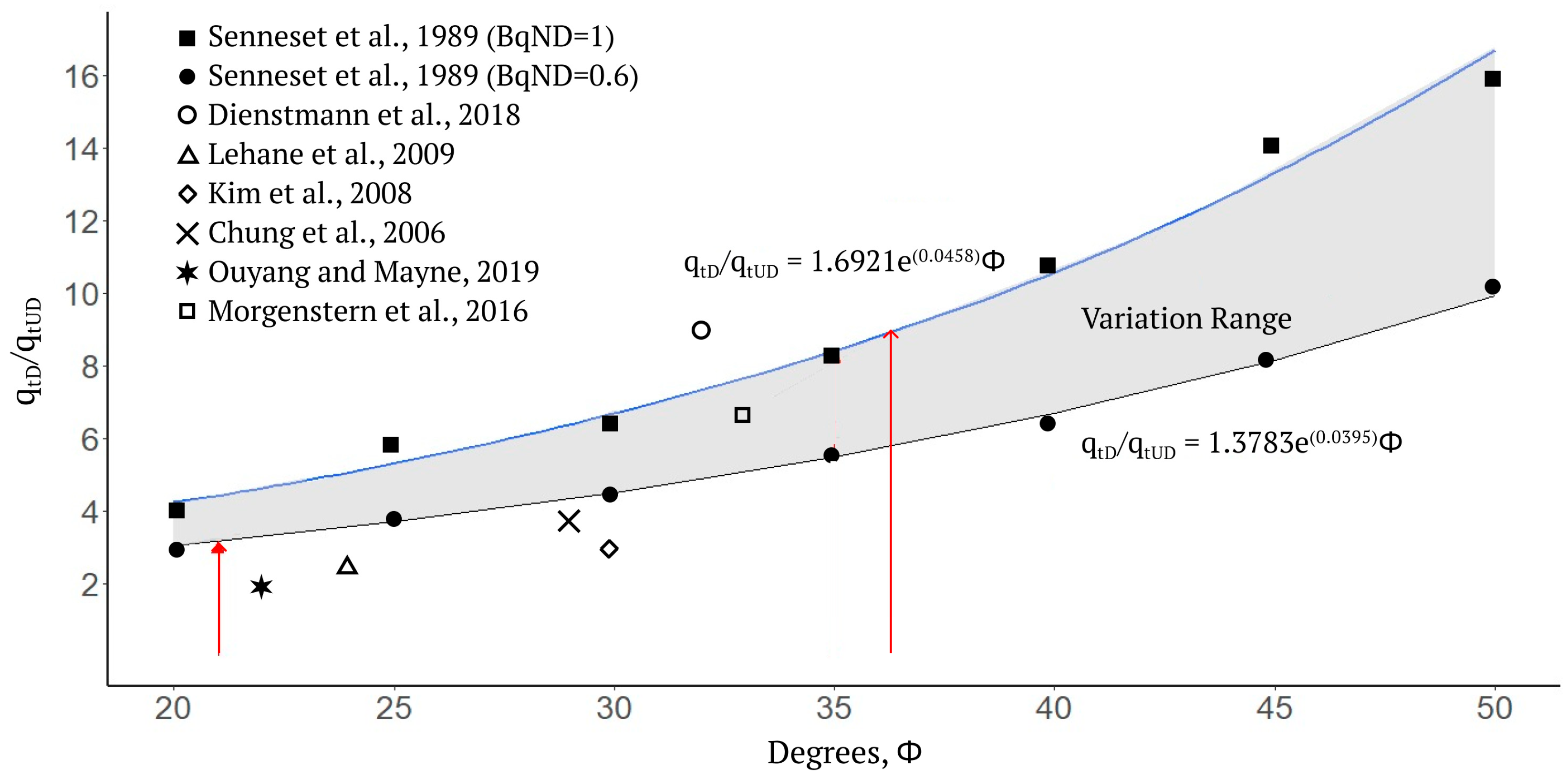
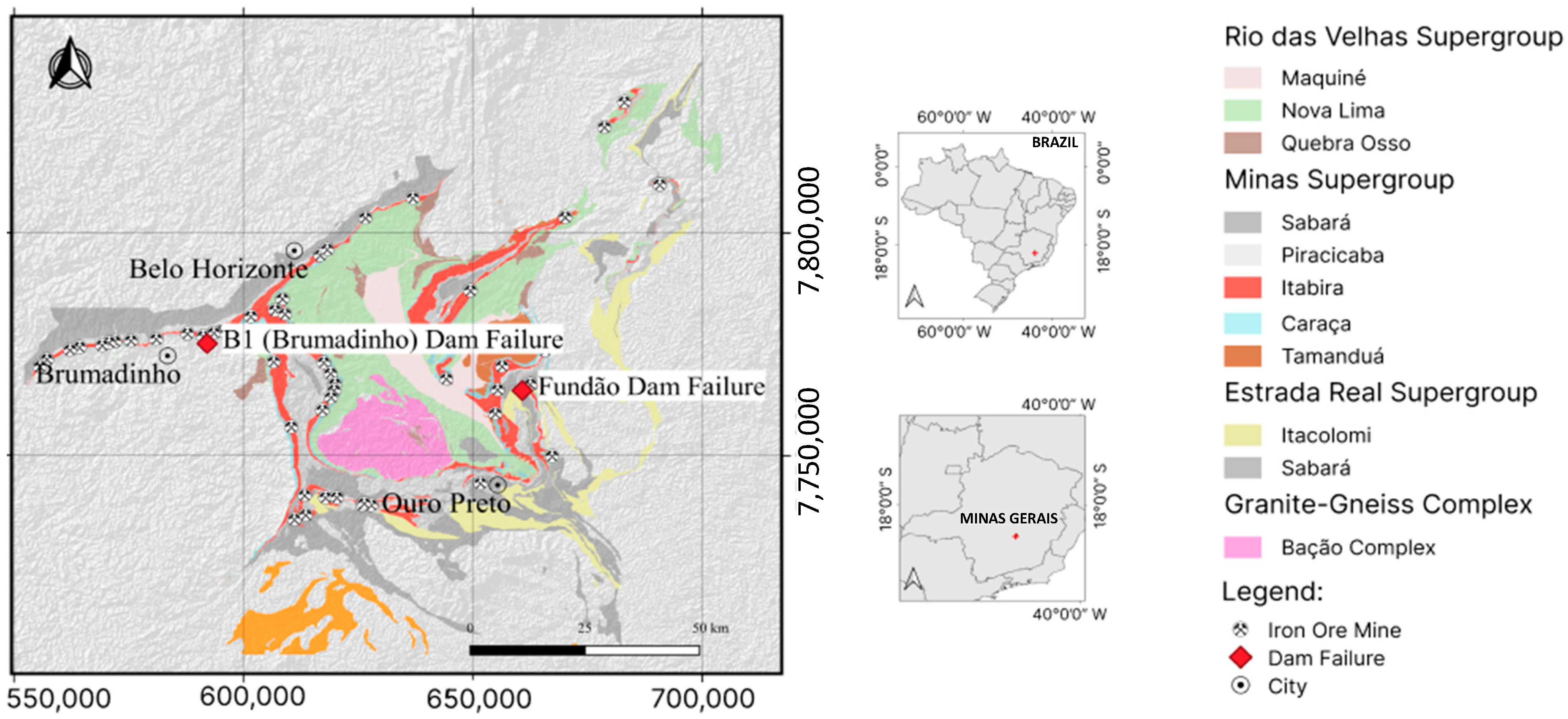
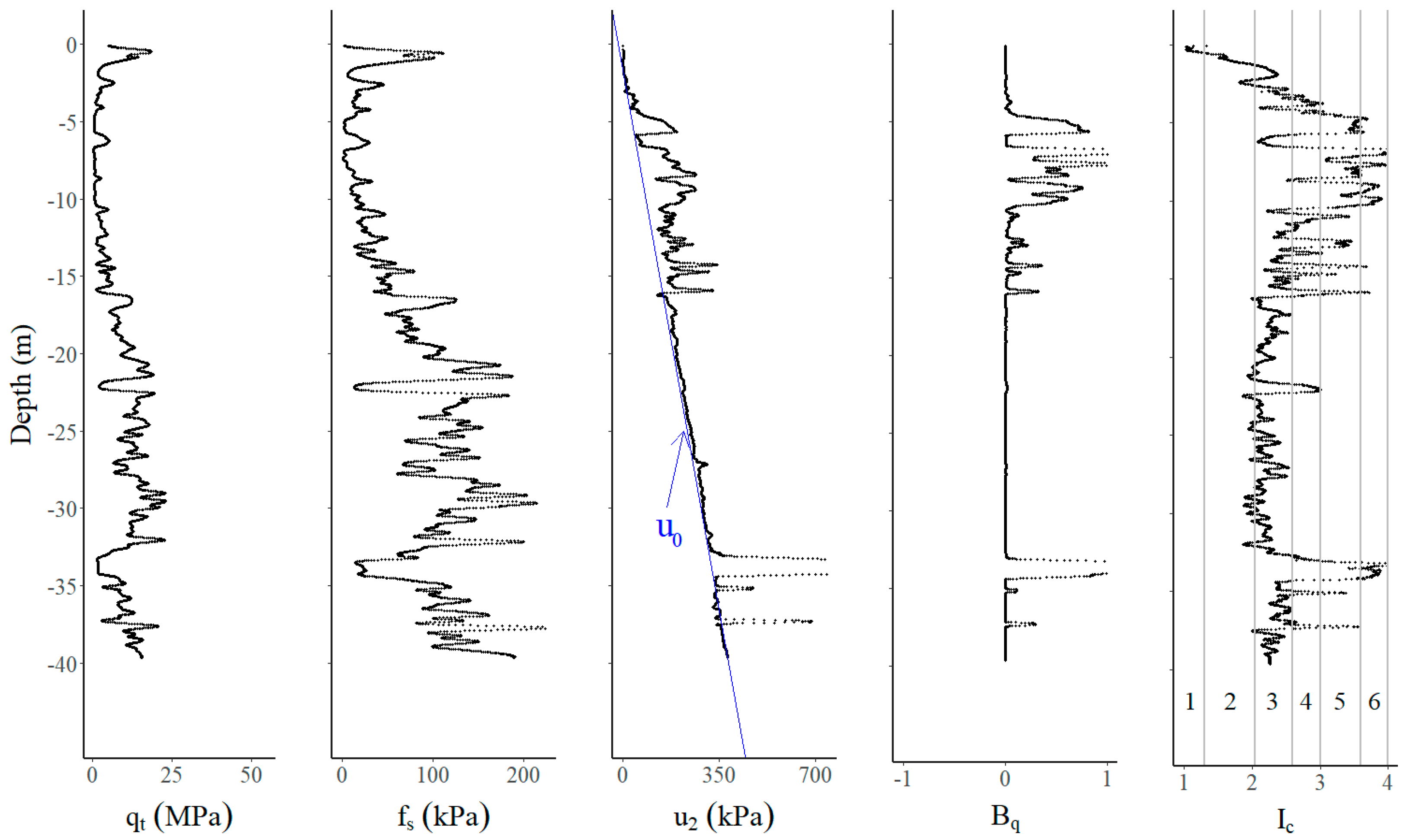

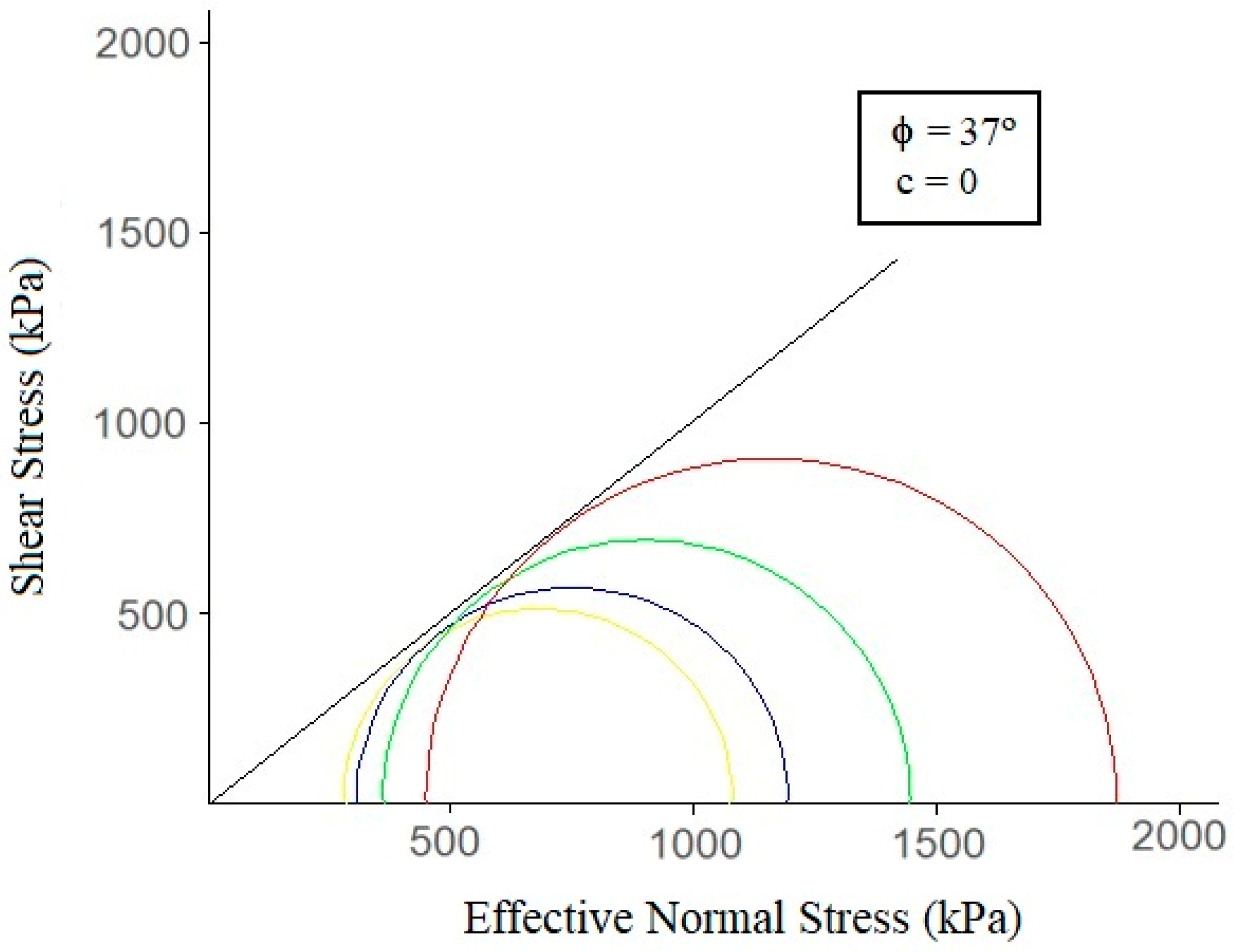
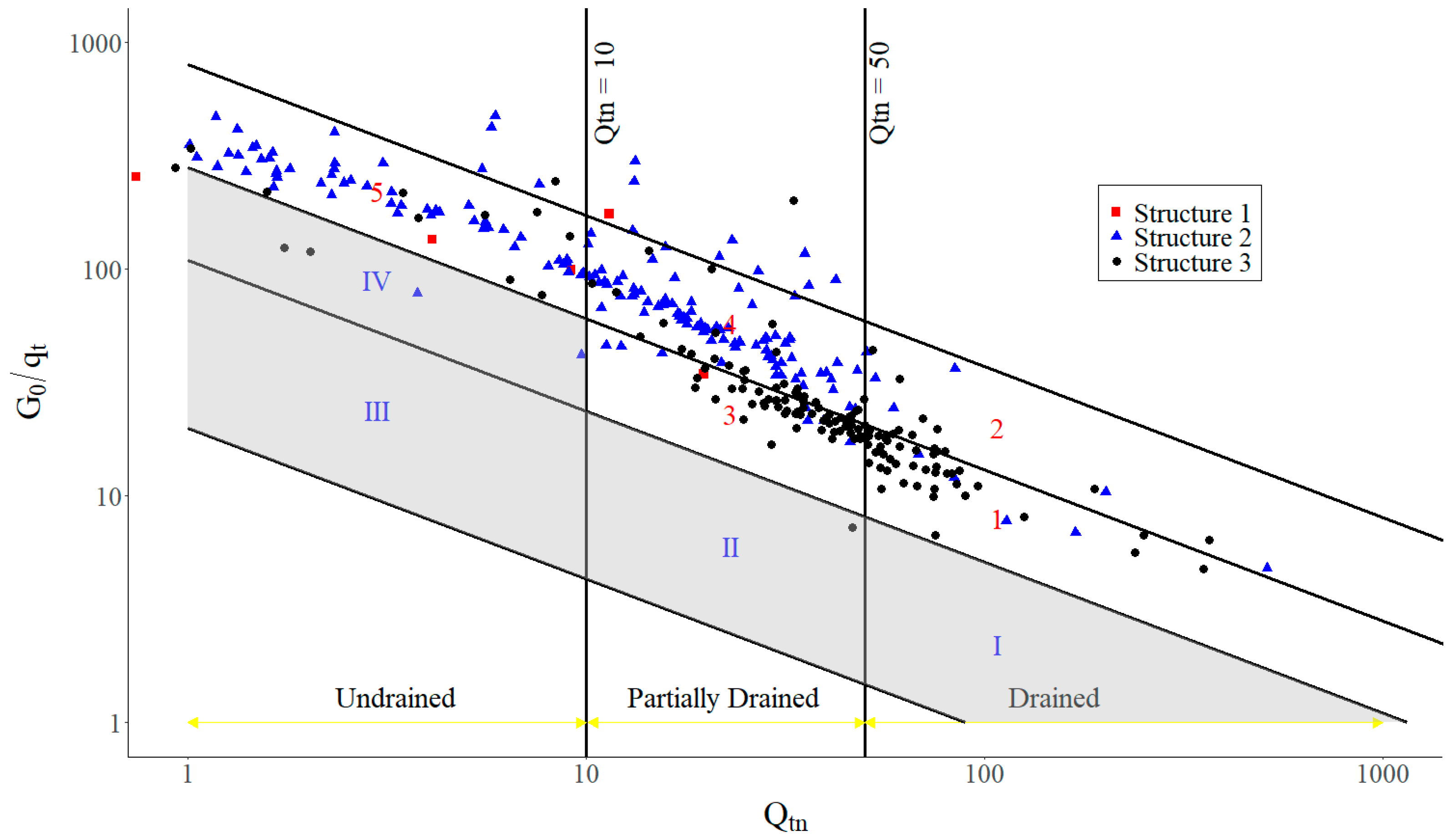
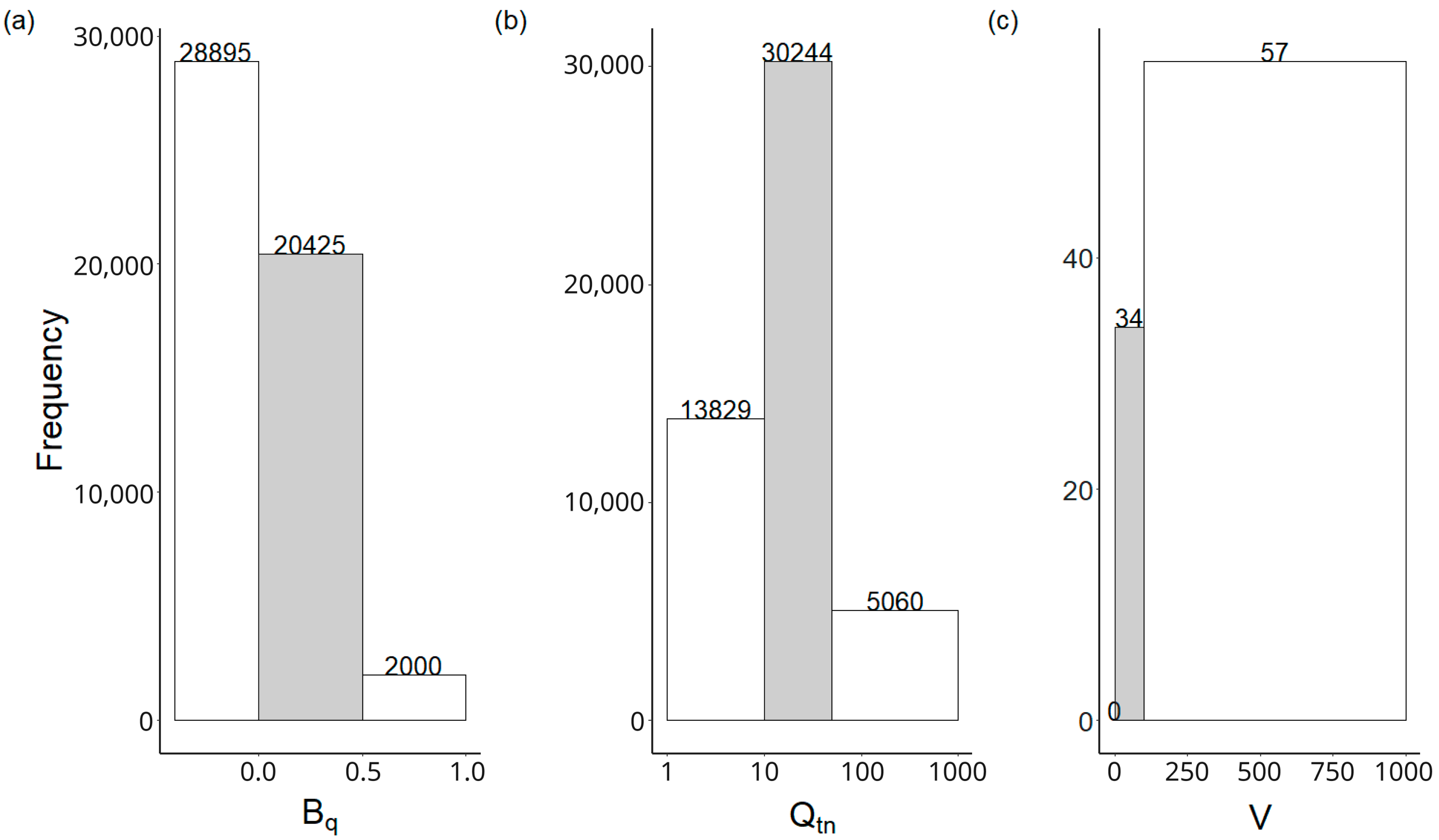

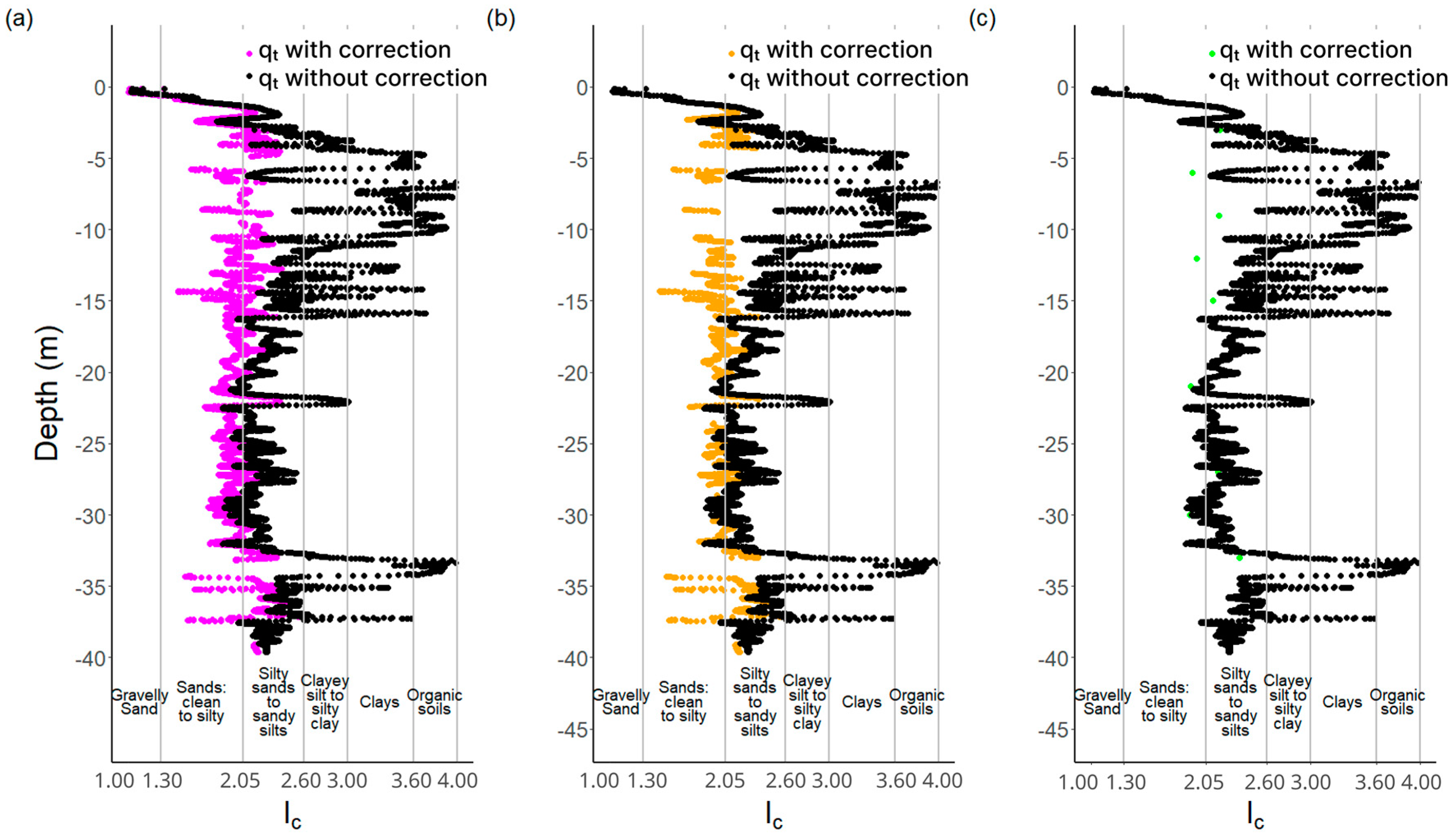
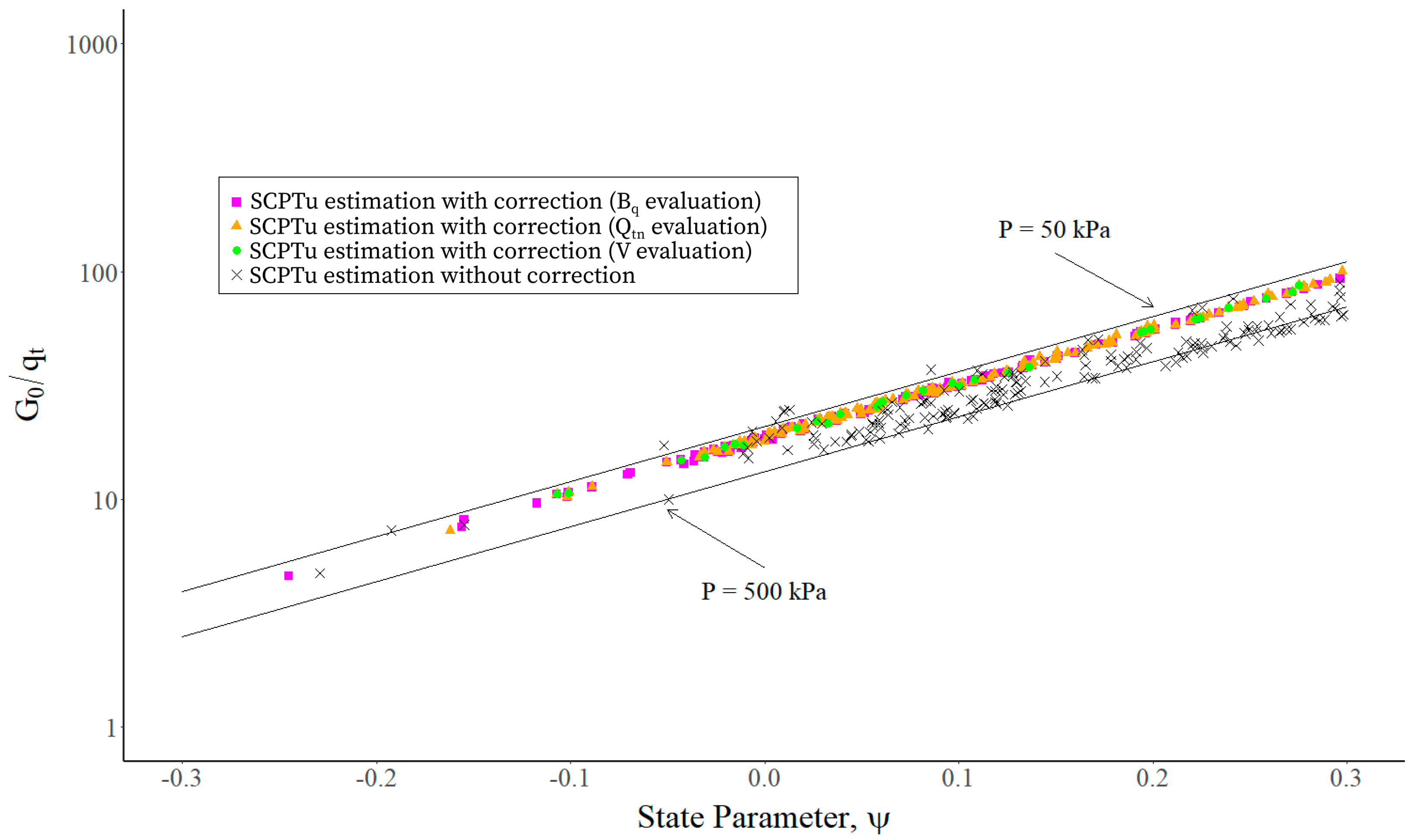
| Structure | Sample Type | Clay (%) | Silt (%) | Sand (%) | D50 (mm) | LL (%) | LP (%) | SG | Void Ratio | Triaxial Type | Cohesion (kPa) | Friction Angle (°) |
|---|---|---|---|---|---|---|---|---|---|---|---|---|
| 1 | Reconstituted | 14.96 | 34.14 | 7.05 | 0.01 | 37.24 | 14.05 | 2.84 | 1.03 | CIDSat | 42.48 | 33.46 |
| 1 | Disturbed | 53.98 | 16.04 | 19.28 | 0.001 | 38.34 | 11.52 | 3.04 | * | * | * | * |
| 1 | Disturbed | 57.08 | 19.29 | 19.82 | 0.001 | 59.75 | 26.94 | 2.94 | * | * | * | * |
| 1 | Disturbed | 65.92 | 23.36 | 10.71 | - | 43.44 | 14.61 | 3.15 | * | * | * | * |
| 1 | Reconstituted | 19.15 | 60.82 | 17.6 | 0.01 | 54.34 | 23.57 | 2.87 | 1.01 | CIUSat | 20 | 37 |
| 1 | Disturbed | 15.25 | 48.26 | 11.97 | 0.01 | 28.34 | 13.98 | 2.82 | * | * | * | * |
| 2 | Reconstituted | 8.81 | 57.1 | 34.1 | 0.01 | / | / | 3.54 | 0.854 | CIUSat | 0 | 23.33 |
| 2 | Reconstituted | 4.96 | 28.79 | 52.31 | 0.1 | / | / | 3.5 | 0.827 | CIUSat | 7.5 | 21.17 |
| 2 | Undisturbed (Shelby) | 4 | 53 | 38 | 0.1 | / | / | 4.66 | * | * | * | * |
| 2 | Undisturbed (Shelby) | 3 | 83 | 14 | 0.01 | / | / | 4.77 | * | * | * | * |
| 2 | Undisturbed (Shelby) | 3 | 81 | 16 | 0.01 | / | / | 4.7 | * | * | * | * |
| 2 | Undisturbed (Shelby) | 4 | 60 | 37 | 0.1 | / | / | 4.37 | * | * | * | * |
| 2 | Undisturbed (Shelby) | 5 | 76 | 19 | 0.01 | / | / | 4.47 | * | * | * | * |
| 3 | Reconstituted | 1.91 | 19.5 | 78.59 | 0.1 | / | / | 3.3 | 0.67 | CIUSat | 0 | 37 |
| 3 | Reconstituted | 3.11 | 24.04 | 72.85 | 0.1 | / | / | 3.38 | 0.653 | CIUSat | 0 | 36 |
| 3 | Reconstituted | 2.81 | 19.18 | 78.02 | 0.1 | / | / | 3.36 | 0.696 | CIUSat | 5 | 36.65 |
Disclaimer/Publisher’s Note: The statements, opinions and data contained in all publications are solely those of the individual author(s) and contributor(s) and not of MDPI and/or the editor(s). MDPI and/or the editor(s) disclaim responsibility for any injury to people or property resulting from any ideas, methods, instructions or products referred to in the content. |
© 2024 by the authors. Licensee MDPI, Basel, Switzerland. This article is an open access article distributed under the terms and conditions of the Creative Commons Attribution (CC BY) license (https://creativecommons.org/licenses/by/4.0/).
Share and Cite
Costa, G.C.L.R.d.; Gomes, G.J.C.; Nierwinski, H.P. Susceptibility to Liquefaction of Iron Ore Tailings in Upstream Dams Considering Drainage Conditions Based on Seismic Piezocone Tests. Appl. Sci. 2024, 14, 6129. https://doi.org/10.3390/app14146129
Costa GCLRd, Gomes GJC, Nierwinski HP. Susceptibility to Liquefaction of Iron Ore Tailings in Upstream Dams Considering Drainage Conditions Based on Seismic Piezocone Tests. Applied Sciences. 2024; 14(14):6129. https://doi.org/10.3390/app14146129
Chicago/Turabian StyleCosta, Giovani C. L. R. da, Guilherme J. C. Gomes, and Helena Paula Nierwinski. 2024. "Susceptibility to Liquefaction of Iron Ore Tailings in Upstream Dams Considering Drainage Conditions Based on Seismic Piezocone Tests" Applied Sciences 14, no. 14: 6129. https://doi.org/10.3390/app14146129
APA StyleCosta, G. C. L. R. d., Gomes, G. J. C., & Nierwinski, H. P. (2024). Susceptibility to Liquefaction of Iron Ore Tailings in Upstream Dams Considering Drainage Conditions Based on Seismic Piezocone Tests. Applied Sciences, 14(14), 6129. https://doi.org/10.3390/app14146129






